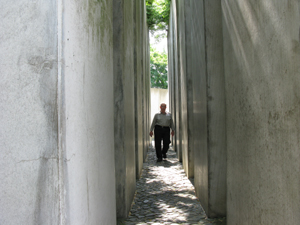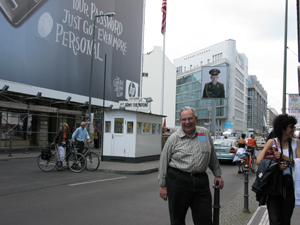The Jewish Museum of Berlin is the largest in Europe. After passing through the security gates we find at many Jewish museums,
visitors walk into the showcase building designed by Daniel Libeskind. First there is  The Garden of Exile
a set of corridors
reflecting the sorrows of the Holocaust. Next we encountered the Garden of Exile, an outdoor rectangular array of granite pillars,
set at a mild slant, with Russian olive trees growing atop each one. Another corridor led to the Holocaust Tower; along the sides of the corridor,
possessions (diaries, a typewriter, contents of a paper sack given to a relative) of Holocaust victims are displayed. At the end
a massive steel door opens into the actual tower, tall, narrow, and dark, with but a tiny slit of a window high above. We found this Holocaust Memorial to be intellectual
The Garden of Exile
a set of corridors
reflecting the sorrows of the Holocaust. Next we encountered the Garden of Exile, an outdoor rectangular array of granite pillars,
set at a mild slant, with Russian olive trees growing atop each one. Another corridor led to the Holocaust Tower; along the sides of the corridor,
possessions (diaries, a typewriter, contents of a paper sack given to a relative) of Holocaust victims are displayed. At the end
a massive steel door opens into the actual tower, tall, narrow, and dark, with but a tiny slit of a window high above. We found this Holocaust Memorial to be intellectual
 Memorial tower Jewish Museum
and abstract; it made us consider the architect more than the subject, although other visitors were clearly moved to remembrance of the horror.
Memorial tower Jewish Museum
and abstract; it made us consider the architect more than the subject, although other visitors were clearly moved to remembrance of the horror.
The remaining corridor leads to the museum, up a long flight of stairs. At the top is a fascinating, beautifully
presented historical museum covering many centuries of Jewish life in Germany. We first visited an artistic special exhibit named
"Typisch!" which exposed, in a gently chiding manner, cliches and stereotypes describing people of all sizes, shapes, and backgrounds. Arabs, Blacks, Indians, Aborigines, Bedouins, Chinese, Japanese, Jews, and more have been the butt of stereotypes forever. Skin color has been "scientifically" studied, much has been made of the shapes of noses. These stereotypes, when presented to children, may easily grow  Five Races of Man poster
into adult prejudice, and certainly spurred on the fad of eugenics which took root in the early twentieth century. Such was the case of a poster of the "Five Races of Man" picturing a handsome European dominating the center. At least two
panels in the "Typisch!" exhibit portrayed potential Holocaust memorials which had been considered too controversial to be implemented.
Five Races of Man poster
into adult prejudice, and certainly spurred on the fad of eugenics which took root in the early twentieth century. Such was the case of a poster of the "Five Races of Man" picturing a handsome European dominating the center. At least two
panels in the "Typisch!" exhibit portrayed potential Holocaust memorials which had been considered too controversial to be implemented.
The permanent exhibits at the Jewish Museum are breathtaking and engrossing. Beginning in the Middle Ages, they show possessions, portraits, and
documents illustrating the lives of Jewish families in German cities. One striking set followed the life of a 14th-century
German woman who, on the death of her husband, took over his business while raising her family. Her  Museum exhibit
detailed diaries and account
books aided in reconstructing her travels and her habits. The exhibit included a portrait of her, in vibrant middle life.
Museum exhibit
detailed diaries and account
books aided in reconstructing her travels and her habits. The exhibit included a portrait of her, in vibrant middle life.
There
was so much to see that we grew tired and hungry before we had finished the tour, despite the fact that we had audiophones for English descriptions of many exhibits. We would happily return to study this museum more thoroughly; we were especially impressed by the skill of the curators in presenting the material and arranging the displays.
Hungry but ready for more sightseeing, we arrived at Checkpoint Charlie, a mock-up of the guard shack which once stopped traffic
at the Berlin Wall. "Russian" and "American" guards posed for photos and gave directions. Walls at each corner of the interesection bore
 At Checkpoint Charlie
billboard-sized posters illustrating the building of the wall and the effects on local life. Nearby we found a Thai restaurant
and enjoyed our second non-German meal (to Emily's relief -- wursts and sausages are not her favorite.)
At Checkpoint Charlie
billboard-sized posters illustrating the building of the wall and the effects on local life. Nearby we found a Thai restaurant
and enjoyed our second non-German meal (to Emily's relief -- wursts and sausages are not her favorite.)
We concluded our day's sightseeing with a visit to the grimmest reminder of the War years so far. It was called The Topography of Terror, and described the work of Heinrich Himmler's Schutzstaffel (SS) which he built into a 50,000-strong unit of fanatical Nazi troops, and encompassing the Gestapo (secret police), the Kripo (criminal police) and the Sipo (security police). Undecided as to where to locate this museum permanently, the Berlin authorities have left it as an open air exhibit next to the brick ruins of Himmler's Gestapo Headquarters at Prinz-Albrecht Strasse 8, and also in the shadow of the Berlin Wall.
These red brick ruins are covered with museum exhibits
illustrating the people and events during the Nazi rule. It includes photos of some of the rebels
who attempted to overthrow Hitler's government, and other Resistance leaders, as well as other places and events of the times.
 Topography of Terror Exhibit
The founders of this archive had hoped to build a permanent museum at the site, but it has been stalled, for various reasons,
for more than a decade. Clearly, it is not for lack of interest, because visitors were thick on the ground, moving slowly,
intently taking in these historic pictures and words.
Topography of Terror Exhibit
The founders of this archive had hoped to build a permanent museum at the site, but it has been stalled, for various reasons,
for more than a decade. Clearly, it is not for lack of interest, because visitors were thick on the ground, moving slowly,
intently taking in these historic pictures and words.
Berlin has several major memorials to the Holocaust. Perhaps it is due to the division of the city that there is no single,
major, unified memorial -- with Checkpoint Charlie, with all of its commercial trappings, as the major tourist draw --
to the dark years of 1932 - 1945. By the time the wall was removed and both sides of the city could work together, time had
passed and new generations wanted to look forward. Nevertheless, visitors to the city find an astonishing variety of memorials
-- statues, rooms, plaques, photos -- throughout the city, and the cumulative effect is more powerful than any single museum could ever be.
 The Garden of Exile
a set of corridors
reflecting the sorrows of the Holocaust. Next we encountered the Garden of Exile, an outdoor rectangular array of granite pillars,
set at a mild slant, with Russian olive trees growing atop each one. Another corridor led to the Holocaust Tower; along the sides of the corridor,
possessions (diaries, a typewriter, contents of a paper sack given to a relative) of Holocaust victims are displayed. At the end
a massive steel door opens into the actual tower, tall, narrow, and dark, with but a tiny slit of a window high above. We found this Holocaust Memorial to be intellectual
The Garden of Exile
a set of corridors
reflecting the sorrows of the Holocaust. Next we encountered the Garden of Exile, an outdoor rectangular array of granite pillars,
set at a mild slant, with Russian olive trees growing atop each one. Another corridor led to the Holocaust Tower; along the sides of the corridor,
possessions (diaries, a typewriter, contents of a paper sack given to a relative) of Holocaust victims are displayed. At the end
a massive steel door opens into the actual tower, tall, narrow, and dark, with but a tiny slit of a window high above. We found this Holocaust Memorial to be intellectual
 Memorial tower Jewish Museum
and abstract; it made us consider the architect more than the subject, although other visitors were clearly moved to remembrance of the horror.
Memorial tower Jewish Museum
and abstract; it made us consider the architect more than the subject, although other visitors were clearly moved to remembrance of the horror.
 Five Races of Man poster
Five Races of Man poster Museum exhibit
Museum exhibit At Checkpoint Charlie
At Checkpoint Charlie Topography of Terror Exhibit
Topography of Terror Exhibit